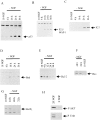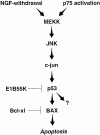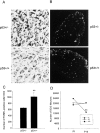p53 is essential for developmental neuron death as regulated by the TrkA and p75 neurotrophin receptors
- PMID: 9852160
- PMCID: PMC2132983
- DOI: 10.1083/jcb.143.6.1691
p53 is essential for developmental neuron death as regulated by the TrkA and p75 neurotrophin receptors
Abstract
Naturally occurring sympathetic neuron death is the result of two apoptotic signaling events: one normally suppressed by NGF/TrkA survival signals, and a second activated by the p75 neurotrophin receptor. Here we demonstrate that the p53 tumor suppressor protein, likely as induced by the MEKK-JNK pathway, is an essential component of both of these apoptotic signaling cascades. In cultured neonatal sympathetic neurons, p53 protein levels are elevated in response to both NGF withdrawal and p75NTR activation. NGF withdrawal also results in elevation of a known p53 target, the apoptotic protein Bax. Functional ablation of p53 using the adenovirus E1B55K protein inhibits neuronal apoptosis as induced by either NGF withdrawal or p75 activation. Direct stimulation of the MEKK-JNK pathway using activated MEKK1 has similar effects; p53 and Bax are increased and the subsequent neuronal apoptosis can be rescued by E1B55K. Expression of p53 in sympathetic neurons indicates that p53 functions downstream of JNK and upstream of Bax. Finally, when p53 levels are reduced or absent in p53+/- or p53-/- mice, naturally occurring sympathetic neuron death is inhibited. Thus, p53 is an essential common component of two receptor-mediated signal transduction cascades that converge on the MEKK-JNK pathway to regulate the developmental death of sympathetic neurons.
Figures







References
-
- Boise LH, Gonzalez-Garcia M, Postema CE, Ding L, Lindstem T, Turka LA, Mao X, Nunez G, Thompson CB. Bcl-xl, a bcl-2 related gene that functions as a dominant regulator of apoptotic cell death. Cell. 1993;74:597–608. - PubMed
-
- Caelles C, Helmberg A, Karin M. p53-dependent apoptosis in the absence of transcriptional activation of p53 target genes. Nature. 1994;370:220–223. - PubMed
Publication types
MeSH terms
Substances
LinkOut - more resources
Full Text Sources
Other Literature Sources
Research Materials
Miscellaneous

